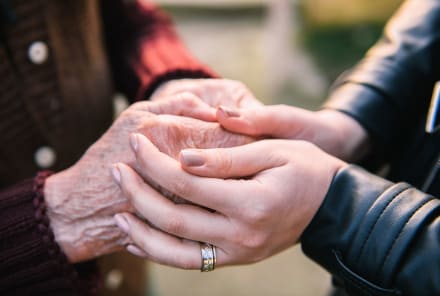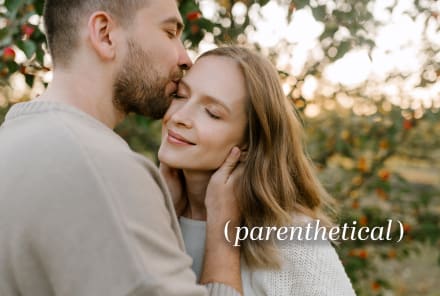Advertisement
Understanding The Fearful Avoidant Attachment Style In Relationships


According to attachment theory, our approach to forming relationships with other people is a direct reflection of our earliest experiences with our caregivers, as well as other influential relationships in our life. There are three main adult attachment styles: secure, anxious, and avoidant. But there's also a fourth attachment style that's much more rare and thus hardly talked about: fearful-avoidant attachment.
What is fearful-avoidant attachment?
Fearful-avoidant attachment is a pattern of behavior in relationships that is marked by both high anxiety and high avoidance, wherein a person both craves connection but also fears getting too close to anyone. Also known as disorganized attachment, it's the rarest of the four attachment styles.
The fearful-avoidant attachment style is considered to be a combination of the anxious attachment style and the avoidant attachment style. People with an anxious attachment style are constantly seeking more intimacy and reassurances in their relationships, often coming off as "needy" partners, whereas people with an avoidant attachment style tend to do the opposite and push others away out of a fear of intimacy.
But the fearful-avoidant attachment style involves a combination of both feeling anxious for affection and avoiding it at all costs. A 2019 study1 published in the Journal of Sex & Marital Therapy describes it as "reluctant to engage in a close relationship and a dire need to be loved by others."
According to psychologists Nicolas Favez and Herve Tissot, the researchers behind the study, this attachment style is seldom talked about and not well-researched because it's much rarer than the other three attachment styles. But some research has found fearful-avoidant people to have "the most psychological and relational risks."
Summary
Common behaviors and signs of fearful-avoidant attachment
A few that Favez and Tissot mention in their study:
- Fear of intimacy or fear of relationships in general
- Avoiding commitment in relationships
- Elevated anxiety
- Negative view of themselves; feeling undeserving of healthy relationships
- Severe difficulty regulating emotions in relationships
- Responding poorly or inappropriately to negative emotions
- Perceiving other people and their support negatively
- Higher likelihood of showing violence in their relationships
- Having a high number of sexual partners
- Generally feeling unsatisfied with relationships
"Fearful avoidance or disorganization has also been shown to be linked2 with borderline personality disorders or dissociative symptoms," they write.
You can take this five-minute attachment style quiz to determine your attachment style. In general though, it might hard to tell if you have the fearful-avoidant attachment style without consulting with a professional, in part because it tends to present a combination of behaviors that also align with both the anxious and avoidant attachment styles.
What causes fearful-avoidant attachment?
Attachment styles are thought to form in early childhood based on a person's relationship with their earliest caregivers. People who grew up with trustworthy caregivers who engaged in consistent ways with them (including a lot of love and attention) generally end up with a secure attachment style, meaning they have generally healthy relationships where they feel secure, loved, and able to love back.
Those whose parental relationships were unreliable, nonexistent, or troubled tend to end up with one of the three insecure attachment style, whether anxious, avoidant, or fearful-avoidant.
Some studies suggest trauma might be a key factor in the development of fearful-avoidant attachment, Favez and Tissot write. As children, those with fearful avoidance react to stress with "apparently incoherent behaviors," they explain, such as aimlessness, fear of their caregiver, or aggressiveness toward their caregiver. Earlier studies have hypothesized this behavior comes from abuse or other traumatic experiences with their caregiver. In response, the child becomes "constantly caught between deactivation (as the attachment figure cannot be a source of reassurance) and hyperactivation (the presence of the 'frightening' figure constantly triggers attachment needs)."
In other words, a child who is afraid of their caregiver finds themselves desperately needing comfort but has learned that they cannot trust the person who gives it to them. In adulthood, this manifests as both wanting intimacy in your relationships but instinctively fearing it and trying to escape it.
Summary
How fearful-avoidant attachment affects relationships
People with a fearful-avoidant attachment style tend to have either very troubled relationships or very tenuous, distant ones that lack real intimacy or commitment. That's usually because of the way fearful-avoidant people may behave in relationships.
"It is displayed in adults through poor coping skills, a lack of coping strategies, erratic behavior, and difficulty dealing with issues in relationships and in real-life problems," therapist Chamin Ajjan, M.S., LCSW, A-CBT, previously told mbg of this disorganized attachment style. "[They] can be unpredictable and volatile in relationships." These behaviors can make for chaotic, intense, or even abusive relationships.
Alternatively, some fearful-avoidant people may generally not enter into committed relationships at all. People with this attachment style tend to both seek out connection and closeness while simultaneously trying to avoid actually entering into a serious relationship, so instead they may be more likely to find themselves in a prolonged courtship that never actually turns into a relationship, "situationships," casual sexual relationships, or relationships without labels.
While all of these types of relationships can be approached in healthy ways, often fearful-avoidants end up in these dynamics not because they want them that way but because they're afraid of getting closer and leaning in fully. They may be unable to fully trust that someone will actually commit and be there for them, whether because of a core lack of self-worth, a core lack of trust in others, or some combination of the two.
Some people with the fearful-avoidant attachment style may also fear how a relationship will impact them or their lives, worried about "losing themself" in some way or getting hurt. But at the same time, they find themselves seeking out the closeness and connection of partnership to get their emotional needs met. This can lead to an endless cycle of approach and avoid with potential partners, which can often look like a serious of confusing, incoherent behaviors and mixed signals.
Summary
How it affects sexual relationships
Favez and Tissot's study, which surveyed 600 men and women about their relationships and sex lives, found people with a fearful-avoidant attachment style tend to have a lot more sexual partners than other people. They also tended to be a lot more sexually compliant, which means when someone asks to have sex with you, you're more likely to say yes whether or not you really want it. Put otherwise, while plenty of people have lot of sex with many different partners for the physical pleasure, the excitement, or any number of other reasons, fearful-avoidants might find themselves having a lot of sex with a lot of different people even if they're not that interested in the sex itself.
Why? The researchers theorized these behaviors develop in response to the confusion of both wanting connection but also feeling repulsed by it. "The elevated anxiety felt in fearful avoidance may motivate the individual to increase closeness with a partner by using sexual activities, whereas the elevated avoidance tendency may almost simultaneously motivate the individual to break the bond with this partner...which is in turn followed by the search for a new partner."
Plenty of research3 has also found some people who experience sexual trauma respond by becoming "hypersexual" (i.e., having tons of sex with a lot of different people, sometimes in risky ways), and trauma has also been linked to the development of fearful-avoidant attachment.
Of course, a lifestyle involving having a lot of sex with a lot of different partners can be perfectly healthy for some people with the right set of physical and emotional precautions. But doing it out of a simultaneous craving for and fear of connection can quickly become draining and perhaps even destructive, especially if you start finding yourself saying yes to sex you don't want or sex that puts your well-being at risk. Likewise, if you're breaking connections with people when you really desire to get closer to them, you're putting your mind and heart through a lot of heartache due to your own fears.
Summary
How to deal with fearful-avoidant attachment
If you're relating to any of the above and feeling nervous, take a deep breath. The good news is that attachment styles are malleable and can be adjusted through conscious intention and practice. You can change your attachment style. Here's how to get things back on track if you have fearful-avoidant attachment:
Look into therapy.
If your fearful avoidance really is tied to experiencing trauma in childhood, therapy must play an important role in healing from this attachment wound. Favez and Tissot recommend pursuing a type of therapy that focuses on attachment, such as emotionally focused couple therapy.
Develop a mindfulness practice.
It's essential that you start understanding why you make the decisions you make regarding your relationships, and mindfulness—the practice of being present and aware of one's emotions—can be a good way to work on building up your self-awareness.
"In relationships, shifting from reactiveness to responsiveness can lift us out of our early attachment patterns toward a healthier, more secure style," licensed marriage and family therapist Linda Carroll, M.S., writes at mbg. "Next time you feel a partner coming too close or moving too far away, listen to what each of you is saying and how it's said. You might notice that your words in emotional situations trigger a physiological reaction of fight or flight. Simply becoming aware of each other's old fears is the first step in preventing them from controlling us."
Be honest with your partners.
If your goal is to ultimately form a close emotional bond with someone, you'll need to tell that person exactly what you want and why you struggle with it. This way, you can both work on solutions to help overcome your hurdles and get closer.
"With any prospective partner you meet, you should be honest about your own attachment type and what it means," Peter Lovenheim, author of The Attachment Effect: Exploring the Powerful Ways Our Earliest Bond Shapes Our Relationships and Lives, writes at mbg. "There's no point in pretending to be more eager than you are for intimacy, cuddles, and soul-mating. You want, after all, to find someone who accepts your attachment type and will be comfortable with you just as you are."
Get real about self-compassion.
This isn't just a feel-good catchphrase for you. At core, people with fearful-avoidant personalities are suffering from relationship insecurity—an instilled belief that people in your life are going to reject or leave you, just like your earliest caregivers or loved ones did. You need to actively work to break that toxic mindset that views yourself as unworthy because of what happened in your past.
"Here's the truth: There's no person out there who can heal your attachment issues," couples counselor Margaret Paul, Ph.D., tells mbg. "True healing occurs when you learn to be the loving parent that you never had to yourself. In what ways did your childhood hurt you? How can you give yourself the security, support, and validation you never had?"
Watch Next
Enjoy some of our favorite clips from classes
Enjoy some of our favorite clips from classes
What Is Meditation?
Mindfulness/Spirituality | Light Watkins
Box Breathing
Mindfulness/Spirituality | Gwen Dittmar
What Breathwork Can Address
Mindfulness/Spirituality | Gwen Dittmar
The 8 Limbs of Yoga - What is Asana?
Yoga | Caley Alyssa
Two Standing Postures to Open Up Tight Hips
Yoga | Caley Alyssa
How Plants Can Optimize Athletic Performance
Nutrition | Rich Roll
What to Eat Before a Workout
Nutrition | Rich Roll
How Ayurveda Helps Us Navigate Modern Life
Nutrition | Sahara Rose
Messages About Love & Relationships
Love & Relationships | Esther Perel
Love Languages
Love & Relationships | Esther Perel
What Is Meditation?
Box Breathing
What Breathwork Can Address
The 8 Limbs of Yoga - What is Asana?
Two Standing Postures to Open Up Tight Hips
How Plants Can Optimize Athletic Performance
What to Eat Before a Workout
How Ayurveda Helps Us Navigate Modern Life
Messages About Love & Relationships
Love Languages
Advertisement

The 4 Pillars That Lead To Long-Lasting Relationships, From A Marriage Counselor
Rachel Glik, Ed.D., LPC

The 4 Pillars That Lead To Long-Lasting Relationships, From A Marriage Counselor
Rachel Glik, Ed.D., LPC









